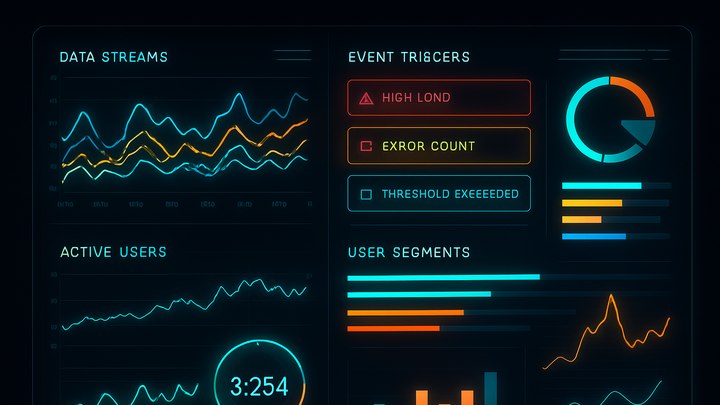Published on 2025-06-26T05:31:03Z
What is Active Analytics? Examples and SaaS Implementations
Active Analytics is a proactive approach in digital analytics that focuses on capturing, analyzing, and acting on user interactions in real time. Rather than relying solely on retrospective reports, Active Analytics uses event-driven tracking, automated triggers, and feedback loops to optimize user experiences instantly. This approach empowers teams to personalize content, run dynamic A/B tests, and send timely alerts or recommendations as users navigate a website or app. Tools like PlainSignal and Google Analytics 4 (GA4) can implement Active Analytics by integrating cookie-free tracking scripts and custom event listeners. By continuously refining experiences based on live data, organizations can improve engagement, reduce churn, and increase conversion rates.
Active analytics
Active Analytics proactively captures and acts on real-time user data via automated triggers and event-driven insights.
Overview of Active Analytics
This section introduces the core concept of Active Analytics, its objectives, and how it shifts the analytics paradigm from reactive reporting to proactive engagement.
-
What is active analytics?
Active Analytics is the practice of continuously collecting user interaction data and immediately using those insights to drive personalized experiences, automated workflows, and dynamic content delivery.
-
Why it matters
By acting on data the moment it’s generated, businesses can reduce latency between insight and action, increasing relevance and impact of every user touchpoint.
Key Characteristics
Active Analytics is defined by several distinguishing features that set it apart from traditional, passive measurement techniques.
-
Event-driven tracking
Focuses on capturing fine-grained user events (clicks, form submissions, video plays) rather than just pageviews or sessions.
-
Automated triggers
Configures rules that fire actions—such as sending a push notification or updating a recommendation engine—when certain events or thresholds are met.
-
Feedback loops
Continuously monitors outcomes of triggered actions (e.g., conversion uplift) to refine future triggers and segmentation logic.
Implementation Examples
Two common ways to implement Active Analytics: using a cookie-free script like PlainSignal or an event-based setup in GA4.
-
Cookie-free tracking with PlainSignal
PlainSignal offers simple, privacy-first analytics that can feed a real-time Active Analytics pipeline without cookies or complex configurations.
-
Tracking code example
<link rel="preconnect" href="//eu.plainsignal.com/" crossorigin /> <script defer data-do="yourwebsitedomain.com" data-id="0GQV1xmtzQQ" data-api="//eu.plainsignal.com" src="//cdn.plainsignal.com/plainsignal-min.js"></script>
-
-
Event-based tracking with google analytics 4
GA4’s event model allows you to define custom events and parameters, then react to them with BigQuery exports or Data API calls for live segmentation.
-
GA4 tracking code
<script async src="https://www.googletagmanager.com/gtag/js?id=GA_MEASUREMENT_ID"></script> <script> window.dataLayer = window.dataLayer || []; function gtag(){dataLayer.push(arguments);} gtag('js', new Date()); gtag('config', 'GA_MEASUREMENT_ID', { 'send_page_view': true }); </script>
-
Benefits and Use Cases
Organizations leverage Active Analytics to drive immediate, data-backed decisions across marketing, product, and customer success.
-
Personalization and engagement
Deliver tailored recommendations or messages within the same session based on real-time behavior.
-
A/b testing and optimization
Automatically allocate users to test variants and adjust allocations on the fly based on performance signals.
-
Churn prevention
Trigger retention offers, in-app prompts, or email outreach when a user’s activity drops below a defined threshold.
